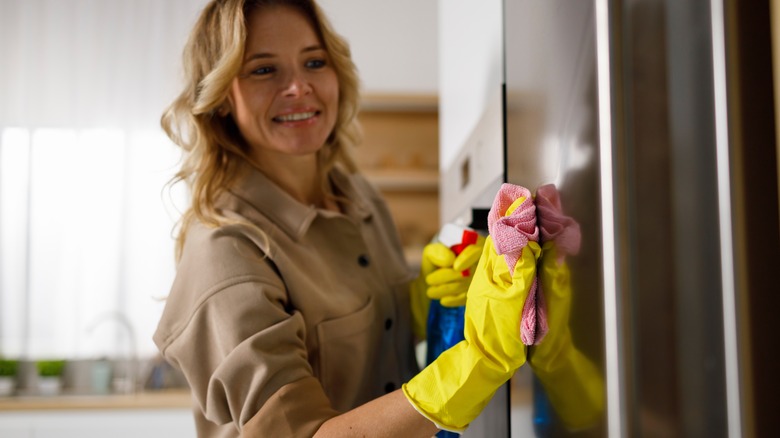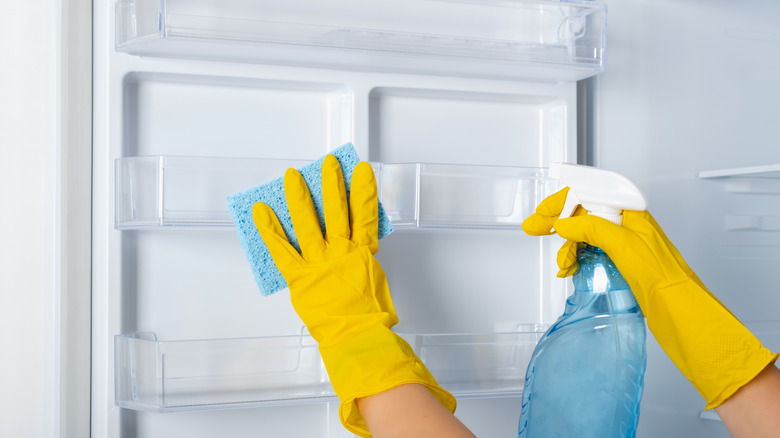How To Clean Your Fridge To Make It Last Longer, According To An Expert
Your refrigerator is probably one of the hardest-working appliances in your home. With the important responsibility of keeping your edible items cool, it's crucial to keep it in good condition so that your food doesn't spoil — and this actually requires some regular maintenance. According to Wilshire Refrigeration & Appliance Inc., one way you can keep your refrigerator from meeting an early demise is to routinely clean the condenser coils. Your condenser is responsible for pulling in warm air and making it cold as it enters your fridge, but over time this important component can sometimes get covered in grime. Luckily, with a monthly vacuum or the careful removal of debris with a soft-bristled brush, you can save your condenser from any damage.
But what about the inside of your fridge? In a House Digest exclusive interview, we asked a certified house cleaning technician with Mattressive, Hugo Guerrero, for more expert advice on how to properly clean your major appliance. His fridge-saving techniques will help you maintain your refrigerator, sparing you the headache and extra expense of buying a new model while keeping your current one fresh and organized.
Thoroughly clean the interior
Over the course of the day, your refrigerator is met with common spills and messes. Although it might not seem like a big deal at the moment, this gunk can cause trouble to the interior of your refrigerator. Food scraps can clog the cooling fan, or leaks can seep into the bottom of your appliance, inducing damage. Stick to a regular cleaning routine will keep your fridge in top working order.
To accomplish this task, cleaning expert Hugo Guerrero first recommends that you "Remove all items from the fridge. Take everything out, including any shelves or drawers." In his professional opinion, "This will give you a clear view of the inside of the fridge and make it easier to clean." As far as cleaning products go, he advises you "Use a mild detergent or a solution of equal parts water and vinegar to wipe down the inside of the fridge." Once you've covered the base, "Be sure to also clean the door seals, as these can accumulate dirt and bacteria over time."
Next, Guerrero recommends that you "Wash the drawers with hot, soapy water," leaving them out to dry before putting them back. Finally, "use a disinfectant spray or wipes to clean any hard-to-reach areas or surfaces that are prone to accumulating bacteria, such as the handles or the drip tray."
Purge old items and organize the rest
Once you have properly cleaned out your refrigerator and are ready to pop all of your food items back into place, there are a few things to consider first. "Discard any food that is past its expiration date or looks or smells spoiled," cleaning expert Hugo Guerrero advises, "This will help reduce the risk of food poisoning and keep your fridge smelling fresh." The last thing you want to do is spend time performing a thorough cleaning just to place old and spoiled items right back in. If you're worried about future fridge aromas, you can also place an open box of baking soda in the back corner of the appliance so that it can absorb any bad odors. For your jars and condiments, it can help to give them a quick wipe with a sponge or cloth that has your vinegar-water solution, so you can clear away any grime from the bottom or sides.
Proper storage can also be key when you are trying to maintain your appliance. "Once your fridge is clean, take a few minutes to organize the items inside," Guerrero recommends, "Place frequently used items at eye level for easy access, and store perishable items at the back of the fridge where it is coldest." Making certain that you don't overfill your fridge can also ensure that the appliance doesn't work too hard to compensate, which could overload the motor.


